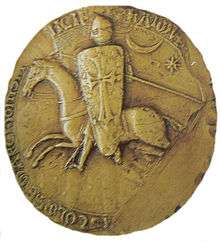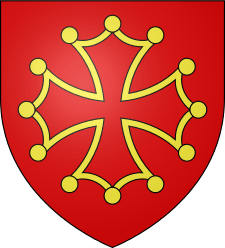Raymond VI, Count of Toulouse
| Raymond VI | |
|---|---|
| Count of Toulouse | |
 Seal of Raymond VI | |
| Born |
27 October 1156 Saint-Gilles, Gard |
| Died | 1 August 1222 |
| Spouse |
Ermessende of Pelet Beatrice of Béziers Bourgogne Joan Plantagenet Eleanor of Aragon |
| Issue |
Constance of Toulouse Raymond VII, Count of Toulouse |
| House | Rouergue |
| Father | Raymond V, Count of Toulouse |
| Mother | Constance of France |
Raymond VI (Occitan: Ramon; October 27, 1156 – August 2, 1222) was Count of Toulouse and Marquis of Provence from 1194 to 1222. He was also (as Raymond IV) Count of Melgueil from 1173 to 1190.
Early life
Born at Saint-Gilles, Gard, he was a son of Raymond V and Constance of France.[1] His maternal grandparents were Louis VI of France and his second wife Adélaide de Maurienne. His maternal uncles included Louis VII of France. In 1194 he succeeded his father as count of Toulouse. He immediately re-established peace with both Alfonso II of Aragon and with the Trencavel.
Marriages
He was married six times:
1. His first wife, Ermessende, Countess of Melgueil, whom he married in 1172, died in 1176 without issue.
2. His second wife was Beatrice of Béziers, sister of Roger II Trencavel;[2] they divorced in 1189 and she was said to have become a Cathar parfaite after the divorce. Raymond and Beatrice had one daughter, Constance of Toulouse, who was married firstly to King Sancho VII of Navarre, and secondly to Pierre-Bermond II of Sauve, lord of Anduze.
3. Raymond then married for a third time, to Bourgogne, daughter of King Amalric II of Jerusalem and his first wife Eschiva of Ibelin, daughter of Baldwin of Ibelin. He divorced her in 1194.
4. His next relationship (marriage, some say) to a daughter of Isaac Komnenos of Cyprus, that ended with divorce.
5. In October 1196 at Rouen he married Joan Plantagenet. She died on 4 Sep 1199. Their only surviving child was Raymond VII, Count of Toulouse (1198–1249).
6. January 1204, in Perpignan, he married his last wife, Eleanor of Aragon, daughter of King Alfonso II of Aragon and Sancha of Castile.[3]
Problems with the Church
Raymond VI held vast territories but his control of them was problematic. Aside from theoretically owing allegiance to the King of France, Raymond held Provence as a vassal of the Emperor.[4] Henry II of England controlled neighboring Aquitaine through his wife Eleanor, who had a claim to Toulouse through her grandmother, Philippa of Toulouse, daughter of William IV, Count of Toulouse. Alfonso II of Aragon was involved in the affairs of Languedoc, stimulating emigration from the north to colonize newly reconquered lands in Aragon.
In Toulouse, Raymond maintained the communal freedoms, extended exemptions from taxation, and extended his protection to the communal territory. A poet and a man of culture, he hated war but did not lack energy.
According to Henri Prienne, "At the end of the 12th century Languedoc was swarming with those mystics who aspired to lead the Church and the age back to apostolic simplicity, condemning both the religious hierarchy and the social order..."[5] At first Innocent III tried to deal with the Cathars by peaceful conversion, sending into the affected regions a number of legates or representatives.[6] Count Raymond declined to assist, although constantly embroiled with his vassals, and given the autonomy of the towns, Kenneth Setton questions whether Raymond "could have coped effectively with the challenge of heresy even if he had wished to do so."[4]
The legates sent from Rome and France received little support as they were considered foreign reformers. Papal legate Pierre de Castelnau was sent to address Raymond's tolerance for the practice of the Cathars, but withdrew for six months in 1206 out of concerns for his safety.
Pierre's assassination on January 15, 1208 led to Raymond's excommunication. The excommunication was lifted after Raymond humbled himself before the Pope.
After the capture and massacre of Béziers, the siege and capture of Carcassonne, and the death of Raymond Roger Trencavel, he moved his camp, was again excommunicated by the Council of Montpellier in 1211, and tried to organize resistance against the Albigensian Crusade. More of a diplomat than a soldier, he was unable to stop the advance of Simon de Montfort, who conquered Toulouse. Raymond was exiled to England under his former brother-in-law John Plantagenet.
In November 1215 Raymond and his son (the later Raymond VII, Count of Toulouse) were in Rome with Raymond-Roger, Count of Foix on the occasion of the Fourth Lateran Council) to vindicate themselves and dispute the loss of their territories. Raymond's son-in-law, Pierre-Bermond II of Sauve, was also there to lay claim to the county of Toulouse, but this claim failed. Raymond and his son went from Rome to Genoa and thence to Marseille in February 1216. Raymond's son set out from Marseille to regain the family territories in Provence; in May 1216 he besieged Beaucaire and captured it on August 24.
Meanwhile, Raymond went to Aragon, hoping to rally support. From there he engaged in secret negotiations with leaders in Toulouse during 1216.[7] Simon de Montfort possibly believed that Raymond was on his way to the city in September 1216;[8] at any rate he returned in great haste from Beaucaire and conducted a partial sack of the city, apparently intended as punishment. Finally, on September 12, 1217, Raymond re-entered Toulouse again. Simon de Montfort immediately besieged the city once more. Simon was killed during the siege (on 25 June 1218); his son Amaury VI of Montfort took his place, and for five years the Crusade faltered.[9] The failure of Louis VIII's campaigns, from 1219 to 1226, finally permitted Raymond, and his son and successor, to recover most of their territories.
Raymond VI is represented as one of four figures on the ceiling of the Minnesota Supreme Court in the United States of America. His painting is next to Moses, Confucius, and Socrates, each painting representing an aspect of law. Raymond VI's painting is entitled "The Adjustment of Conflicting Interests", and the scene is of Raymond VI of Toulouse standing before the papal legate in 1208. Raymond argued successfully for city freedoms, extended exemptions from taxation, and protection of the communal territory from the church. The paintings were made by John LaFarge in 1903.[10]
Notes
- ↑ Jonathan Sumption, The Albigensian Crusade, (Faber and Faber, 1999), 63.
- ↑ Fredric L. Cheyette, Ermengard of Narbonne and the World of the Troubadours, (Cornell University Press, 2001), 26.
- ↑ Moore 2004, p. 39.
- 1 2 Setton, Kenneth Meyer, Wolff. Robert Lee and Hazard, Harry W., A History of the Crusades, Vol. 2, Univ of Wisconsin Press, 1969 ISBN 9780299048440
- ↑ Prienne, Henri. A History of Europe, Routledge, 2010 ISBN 9781136879357
- ↑ "The Cathars an Introduction", International School of Toulouse
- ↑ Chanson de la Croisade Albigeoise laisse 171; Guillaume de Puylaurens, Chronica 27.
- ↑ Peter of les Vaux-de-Cernay, Historia Albigensis 585.
- ↑ "Raymond VI". Retrieved 20 May 2014.
- ↑ Richard C. Kagan (January 20, 2007). "Paintings at Capitol set the stage for Ellison". Star and Tribune. Retrieved on Jan. 21, 2007
Sources
- Smith, Damian J. (2004). "Innocent III and the Crown of Aragon: The Limits of Papal Authority". Church, Faith and Culture in the Medieval West. Aldershot: Ashgate.
External links
| Wikimedia Commons has media related to Raymond VI of Toulouse. |
- Raymond VI entry at the Catholic Encyclopedia
| Preceded by Raymond V |
Counts of Toulouse 1194–1222 |
Succeeded by Raymond VII |
